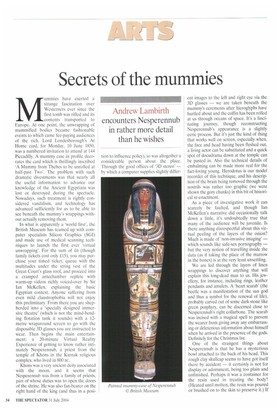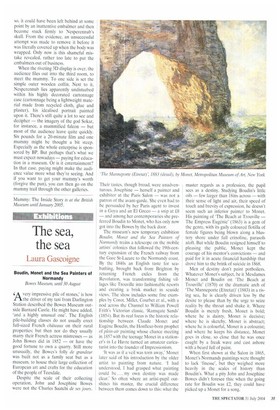Secrets of the mummies
Andrew Lambirth encounters Nesperennub in rather more detail than he wishes
Mummies have exerted a strange fascination over Westerners ever since the first tomb was rifled and its contents transported to Europe. At one point, the unwrapping of mummified bodies became fashionable events to which came fee-paying audiences of the rich. Lord Londesborough's At Home card, for Monday, 10 June 1850, was a numbered invitation to attend at 144 Piccadilly. A mummy case in profile decorates the card which is thrillingly inscribed 'A Mummy from Thebes to be unrolled at half-past Two'. The problem with such dramatic divestments was that nearly all the useful information to advance our knowledge of the Ancient Egyptians was lost or destroyed during the spectacle. Nowadays, such treatment is rightly considered vandalism, and technology has advanced sufficiently for us to be able to see beneath the mummy's wrappings without actually removing them.
In what is apparently a 'world first', the British Museum has teamed up with computer specialists Silicon Graphics (SGI) and made use of medical scanning techniques to launch the first ever .virtual unwrapping'. For the sum of £6 (though family tickets cost only £15), you may purchase your timed ticket, queue with the multitudes under the string vest of the Great Court's glass roof, and proceed into a cramped antechamber replete with warm-up videos richly voiced-over by Sir Ian McKellen, explaining the basic Egyptian context. Anyone suffering from even mild claustrophobia will not enjoy this preliminary. From there you are shepherded into a 'specially designed immersive theatre' (which is not the mind-bending flotation tank it sounds) with a 12metre wraparound screen to go with the disposable 3D glasses you are instructed to wear. Then begins the main entertainment: a 20-minute Virtual Reality Experience of getting to know rather intimately Nesperennub, a priest from the temple of Khons in the Karnak religious complex, who lived in 800 BC.
Khans was a very ancient deity associated with the moon, and it seems that Nesperennub was from a family of priests, part of whose duties was to open the doors of the shrine. He was also fan-bearer on the right hand of the king (and thus in a posi tion to influence policy), so was altogether a considerable person about the place. Through the good offices of '3D stereo' — by which a computer supplies slightly differ ent images to the left and right eye via the 3D glasses — we are taken beneath the mummy's cerements after hieroglyphs have hurtled about and the coffin has been rolled at us through oceans of space. It's a fascinating journey, though reconstructing Nesperennub's appearance is a slightly eerie process. But it's just the kind of thing that works well on screen, especially when, the face and head having been fleshed out, a living actor can be substituted and a quick spot of docudrama down at the temple can be pasted in. Also the technical details of embalming can be made more real for the fact-loving young. Herodotus is our model recorder of this technique, and his description of the brain being removed through the nostrils was rather too graphic (we were shown the gory chunks) in this bit of historical re-enactment.
As a piece of investigative work it can scarcely be faulted, and though Ian McKellen's narrative did occasionally talk down a little, it's undoubtedly true that many of the audience will be juvenile. Is there anything disrespectful about this virtual peeling of the layers of the onion? Much is made of 'non-invasive imaging' — which sounds like safe-sex pornography — but the very notion of travelling inside the data (as if taking the place of the marrow in the bones) is at the very least unsettling.
We are led through the layers of linen wrappings to discover anything that will explain this long-dead man to us. His jewellery, for instance, including rings, leather pendants and amulets. A 'heart scarab' (the beetle was a manifestation of the sun god and thus a symbol for the renewal of life), probably carved out of some dark stone like green porphyry, can be discerned close to Nesperennub's right collarbone. The scarab was incised with a magical spell to prevent the wearer from giving away any embarrassing or deleterious information about himself when he arrived in the presence of the gods. Definitely for the Christmas list.
One of the strangest things about Nesperennub is that he has a mysterious bowl attached to the back of his head. This rough clay skullcap seems to have got itself there by accident — it certainly is not for display or adornment, being too plain and unfinished. Perhaps it was a container for the resin used in treating the body? (Heated until molten, the resin was poured or brushed on to the skin to preserve it.) If so, it could have been left behind at some point by an inattentive embalmer and then become stuck firmly to Nesperennub's skull. From the evidence, an unsuccessful attempt was made to remove it before it was literally covered up when the body was wrapped. Only now is this shameful mistake revealed, rather too late to put the embalmers out of business.
When the riveting 3D display is over, the audience files out into the third room, to meet the mummy. To one side is set the simple outer wooden coffin. Next to it, Nesperennub lies apparently undisturbed within his highly decorated cartonnage case (cartonnage being a lightweight material made from recycled cloth, glue and plaster), his idealised portrait painted upon it. There's still quite a lot to see and decipher — the imagery of the god Sokar, for instance, a mummified falcon — but most of the audience leave quite quickly. Six pounds for a 20-minute film and one mummy might be thought a bit steep. Especially as the whole enterprise is sponsored by BP. But perhaps that's what we must expect nowadays — paying for education in a museum. Or is it entertainment? In that case, paying might make the audience value more what they're seeing. And if you want to get your mummy's worth (forgive the pun), you can then go on the mummy trail through the other galleries.
Mummy: The Inside Story is at the British Museum until January 2005



























































 Previous page
Previous page